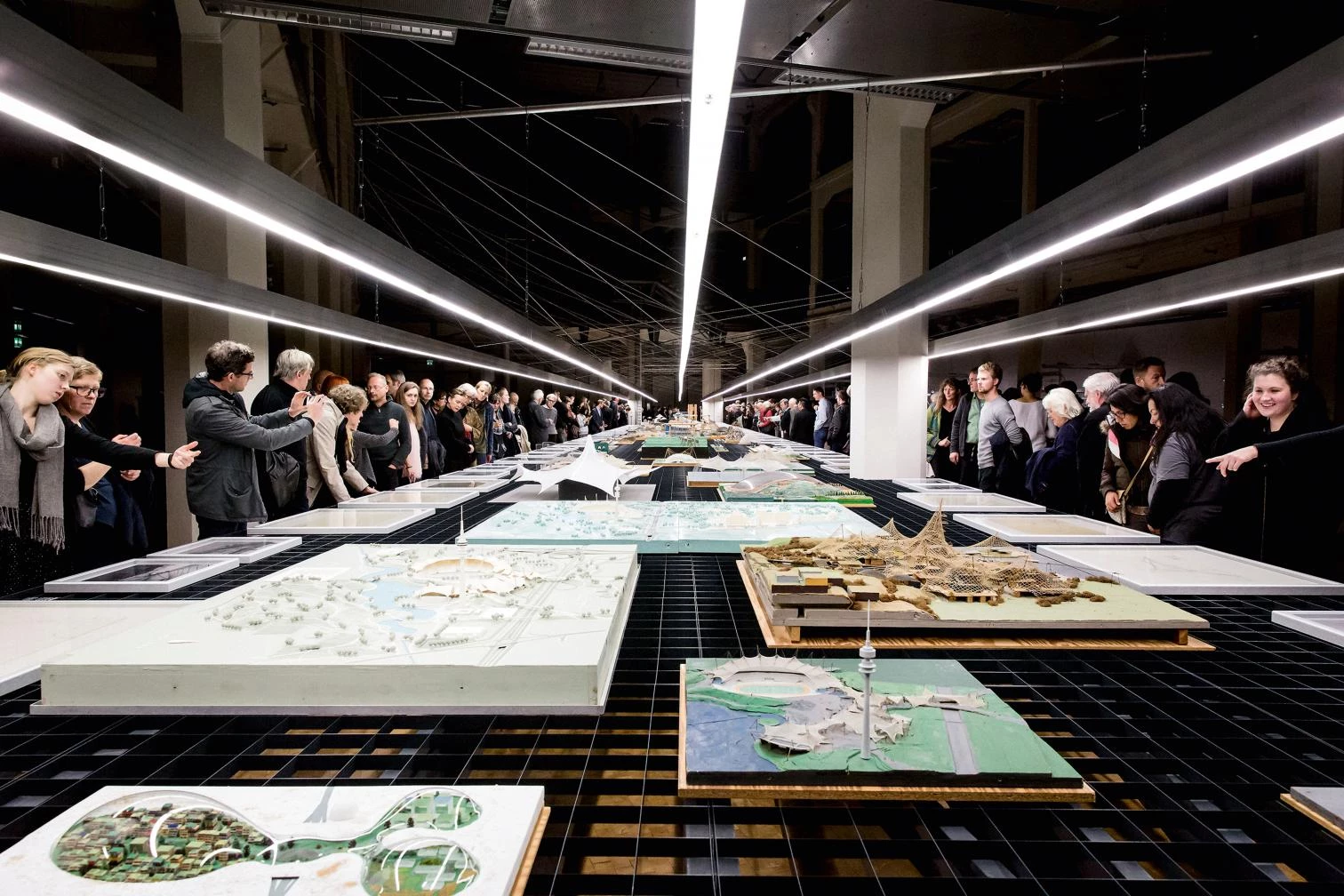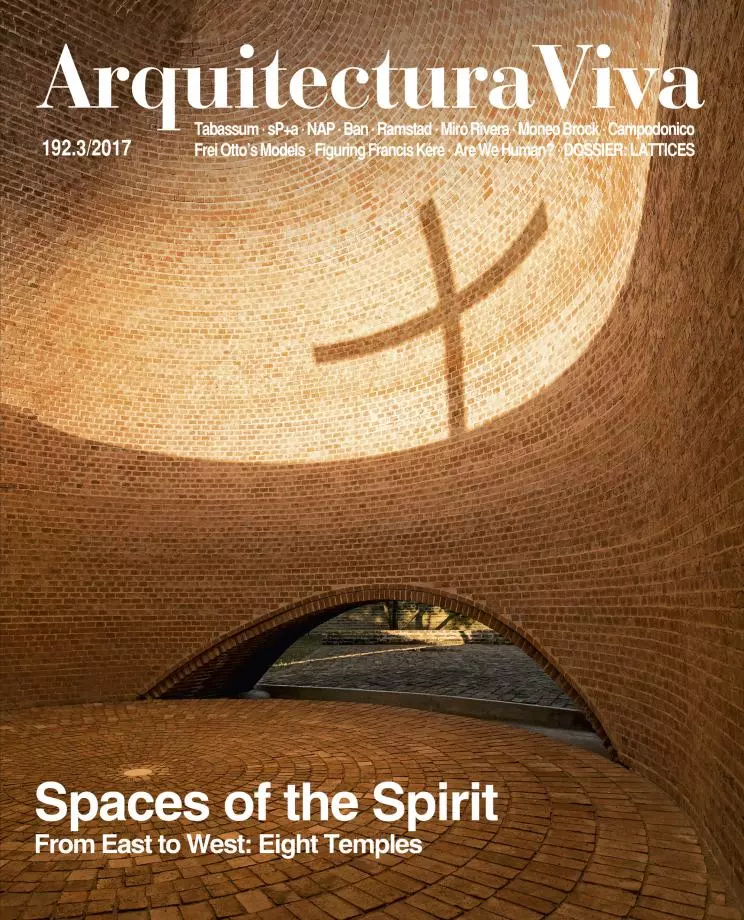
The ethereal architecture of Frei Otto (1925-2015) is enjoying currency at a time of strong ecological pressures. Technical ingenuity, responsible use of resources, and natural appearance of forms could be understood as contributions to the contemporary discourse on ‘smart’ cities and ‘smart’ buildings. Otto’s oeuvre, however, transcends mere technical scientific sophistication, and in many ways places itself in the antipodes of digital abstractions. His numerous writings show his cultural vocation and social commitments, even his extravagant, esoteric aspirations to be a demiurgic architect. Less explicit, and thus more suggestive, is the presence of this ideology in what were the main tools in his work: his models. Two hundred of them are on view at the Zentrum für Kunst und Medientechnologie (ZKM) in Karlsruhe, in an exhibition curated by Georg Vrachliotis and titled ‘Frei Otto: Denken in Modellen.’
The ambiguity of ‘models’ that the title expresses seeks to elucidate the relationship that Otto established between the use of the ‘model’ as a scheme for thought, and the use of it simply as miniatures for generating, verifying, and conveying forms and ideas. There are rough models and delicate ones, laboratory instruments and workshop tools, made with methacrylate or wire, clay or wood, sand or hairspray. With few exceptions, they have in common what Vrachliotis calls an “aesthetic operative”; that is, the predominance of the instrumental value in the search for empirical evidences for very different projects. So models could serve to determine the constructive behavior of structures, and help in the negotiation processes behind the participatory design of housing projects. Occasionally models could even be anticipations of works at the real scale, bringing architecture close to modeling methods of industrial design: we could even consider them prototypes if conceived for serial production. A case in point is the University of Stuttgart’s Institute for Lightweight Structures and Conceptual Design, which Otto directed: a huge cable-structured tent designed, in collaboration with Rolf Gutbrod, as the German Pavilion at the Montreal Expo (1967), the innovative construction of which had to be tested in Germany before being put up in Canada.
Dynamic Systems
The current exhibition, featuring models Otto handed over to the Southwest German Archive for Architecture and Civil Engineering (SAAI) at the Karlsruhe Institute of Technology (KIT), creates the atmosphere of a deposit and workshop, conveying the spirit of collective and interdisciplinary work cultivated by Otto in both the Stuttgart institute and his private practice in Warmbronn. In the two places he prioritized the immediate experience of physical models over the abstractions of calculus, as illustrated by the comparision with the mathematical beauty of the light structures carried out by Félix Candela, with whom Otto, despite differences of approach, had a relationship of mutual admiration.
For Otto, descriptive geometry and calculus were not a priori factors, but instruments for translating knowledge acquired through models. So it is no surprise that he took an interest in the stereo-static model developed by Antoni Gaudí to create the church of Colònia Guëll (1896-1914), which Otto reconstructed in 1982 with his Stuttgart team, in collaboration with the Gaudí Group at TU Delft. The idea was to see up to what point the forms came directly from structural behavior, as in many works of Otto. The model behaved like a dynamic object. In effect, each change in the distribution of weights transformed the entire system of forces in balance, and with it, the resulting forms. But in the case of Gaudí, it wasn’t lightness but archaic heaviness that characterized the propless Gothic of the chapel. Strictly speaking, Otto’s architecture wasn’t only about lightness either. Contrary to what is suggested by the models of the Olympic Stadium of Munich (1968-1972), the real work can only be considered light if we leave out the huge underground masses of cement and the thick cables that anchor the roofs to the ground. Unlike the models, the building gives a powerful tectonic impression. The forces transferred from roof to ground are neither lost nor neutralized by an abstract plane, but tangibly transformed through their continuity in the shape of the slopes. As in the Gothic, empathic perception of the complex inverts the relationship and makes the undulating landscape end in an architectural crown.
Natural Models
In Otto’s work, the notion of a model takes on the sense of mimicry in the field of natural constructions. Indeed, nature was his grand model, and biology the thread of his structural investigations and his social and political activism. We know of his studies of spider webs and his experiments with the minimal surfaces of soap suds, both admirable in their material and energy economy. Even his more utopian projects, such as the environmental bubbles for extreme climates, were based on empirical experiences. Contrary to the analogical visions of Buckminster Fuller, Otto also studied the environmental conditions of those artificial habitats.
It is precisely in the area of ecological concerns, which Otto linked to his social activism in housing policy, that the major novelty of the current exhibition lies. On view are some of his student projects as well as initial works, carried out in the mid-1950s and centered on the search for new public housing solutions. Several models document how this interest of his soon translated into ideas for mixeduse buildings with flexible and multipurpose dwellings. Towards 1959 he proposed urban housing structures generated through analogy with natural growth and adaptation processes, in tune with models developed by Dutch structuralists and Japanese metabolists. We could even say that Otto managed to connect his biological references to their social models.
From this synthesis arose a characteristic combination of ecological and participatory concepts. If the telluric question was present from the start in Otto’s urban and territorial proposals, eventually his residential complexes radicalized and became mountains of artificial caves celebrating attachment to earth, exposure to the sun, rootedness in nature, even in an urban context. The models of his ecological building-tree for the IBA of Berlin are revealing: a succession of horizontal planes, with diaphanous spaces and flexible divisions placed at the disposal of a new, ecologically aware urbanite, who would occupy them by creating a sustainable and partly self-built biotope. Anyone who senses the aesthetic unrest caused by this ecological anarchy in the postmodern environment of those years may be amused to learn that Otto’s own workshop-greenhouse was designed with Rob Krier, who worked with him from 1966 to 1970. Otto’s work can also be understood as the search for alternatives to a modernity he considered counternatural.
In sum, through the models the exhibition expresses the plurality of concepts and work processes developed by Otto with his collaborators, without denying his contradictions and opening up new channels for understanding a complex and visionary oeuvre that serves as a reference as we undertake, responsibly and creatively, the current tasks of urbanizing the planet.





